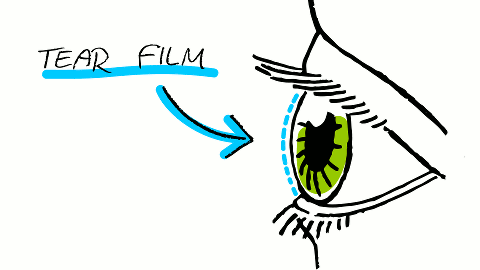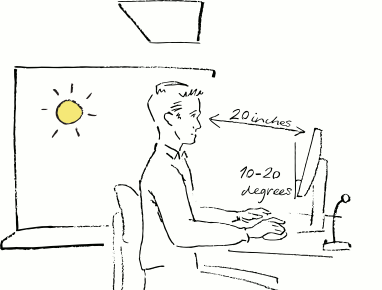Dry eye syndrome
Most computer users, people using contact lenses or working in an air-conditioned environment suffer from dry eye syndrome. It is a multifactorial disease of tears and the ocular surface. Common symptoms are dryness, soreness, scratchiness, eye irritation, blurred vision, burning and even dilated blood vessels (red eyes) at later stages. Reflex tearing, or the eyes "running water," is also common. Typically this is described as the eyes becoming "wet" but with rare spill over (so that the tears rarely run down the cheek). If untreated for a long period of time, it can even lead to eye damage. Dry eye syndrome affects 20% of the general population in Europe, North America and Asia [1].
Ed Jaccoma MD. explains it nicely. We all have two ways to make tears. The first is what we might call the "water sprinkler system". This constant production is coming from the many tiny glands lining the eyelids and this is what normally keeps the eyes moist under most conditions. The second system is what we might call the "fire hose". This is the salty water that comes from the large tear glands responsible for the water we cry with when we get emotional, or when something gets into our eyes. While diagnosing dry eye, you may be found deficient in quantity and/or may be producing poor tear quality or have inflammatory properties that irritate your eyes.
Healthy people blink 10 to 15 times per minute. While working at a computer, the majority of users blink considerably less. Blehm et al. [2] observe up to a 60% reduction in blink rate. We have observed even up to 80% (it varies from person to person). One of the main reasons for our low blink rate is work at a computer. Blinking is related to cognitive processes. When we are focused we will blink less. An additional reason is the brightness of computer screen and its constant position. It is similar to flames: we blink significantly less while looking into the fire. (Try to observe people at barbecue ;)) Due to low blink rate, the tear film is not renewed properly and our eyes get dry.
[1] Benitez-del-Castillo, J.M., Lemp, M.A., Ocular Surface Disorders. Jp Medical Pub 2012
[2] BLEHM, C. et al. Computer Vision Syndrome: A Review. Survey of Ophthalmology. 2005, Available online.
Blinking matters
With each blink, the tear film is renewed. The tear film consists of three sublayers: mucus, watery and oil layer at the top, which protects the eye from dryness (water evaporation). Tear film is a microscopic layer which protects and moisturizes the eye. It is similar to flowers; without water, they dry out. We could also compare it to a car engine which ceases without oil. Blinking matters! It washes out dust and microorganisms. Healthy people have a tear film layer 6 +/- 2.4 micrometers thick, compared to people with dry eye syndrome whose tears have a film of only 2 +/- 1.5 micrometers [3].

Holland and Tarlow [4] say that blinking is related to cognitive processes. Blink rate is low during mental activities like solving arithmetic tasks or daydreaming. A blink occurs together with cognitive change. When solving arithmetic problems, we usually do not blink at all. As soon as we find the solution, we blink. Another example is reading. Most blinks occur at punctuation marks. In contrast, emotional excitement and frustration are related to a high blink rate.
Environmental factors, such as air conditioning, fans, heating systems, low humidity, and dust have negative influence on the tear film quality. Contact lenses often reduce tear film quality. Some people do not fully close their eyes while blinking. As a result, their tear film is not fully renewed [5]. Optometrists and ophthalmologists often prescribe artificial tears. The problem is that artificial tears will never heal the disease; they just suppress the symptoms by compensating the missing tear film. The support dry eye treatment is to maintain the tear film quality and humidity also by sufficient blink rate. Eyeblink can help you with this.
[3] BRIGHTBILL, FS, McDONNELL, PJ, McGHEE, CH. Corneal Surgery: Theory Technique and Tissue. 4th edition, Pennsylvania: Mosby Elsevier, 2008.
[4] HOLLAND, M. K. – TARLOW, G. Blinking And Thinking. In Perceptual and Motor Skills, 1975, Available online.
[5] ROSENFIELD, M. Computer vision syndrome: a review of ocular causes and potential treatments. Ophthalmic and Physiological Optics. 2011, Available online.
Meibomian Gland Dysfunction (MGD)
Completeness of the blink is even more important than blink rate. While comparing reading from hard copy and a computer screen, the blink rate does not differ significantly but the number of incomplete blinks increases [6, 7]. Cardona et al. present a study [8] of blink characteristics while playing video games compared to normal conditions. Blink rate can decrease to one half of the baseline levels with a raise in incomplete blinks while playing computer games.
[6] M. Argilés, et al. Blink rate and incomplete blinks in six different controlled hard-copy and electronic reading conditions blink rate and incomplete blinks, Investigative Ophthalmology and Visual Science, 2015, Available online.
[7] C. A. Chu, et al. Blink patterns: Reading from a computer screen versus hard copy. Optometry and Vision Science, 2014, Available online.
[8] G. Cardona, et al. Blink rate, blink amplitude, and tear film integrity during dynamic visual display terminal tasks. Current Eye Research, 2011, Available online.
Why blink completeness matters?
The lipid layer consists of meibum produced by Meibomian glands and it is spread on the eye surface during the complete blink only. Meibomian glands are placed at the rim of eyelids inside the tarsal plate. During eye blink, eyelids need to touch, so the meibum can be spread over the ocular surface to protect it from evaporation. Due to incomplete blinks, the meibum stays in glands. The gland orifices are blocked with clusters of keratotic cells (dried meibum), due to which the Meibomian glands do not work well and the lipid layer does not regenerate properly. Blocked glands can die over time and a dry eye will be a lifelong problem for a person. This state is referred as Meibomian Gland Dysfunction (MGD) [9]. Obstructive MGD is now recognized as the most common cause of the evaporative dry eye. Conscious blink training can help you to alter your blink pattern.
[9] D. R. Korb, et al. Tear film lipid layer thickness as a function of blinking. Cornea, 1994, Available online.
What are the possibilities of dry eye treatment?
The best way to avoid dry eye syndrome is to blink properly. That is why Eyeblink should accompany you while working at computer. There are several other recommendations that can help you fight this disease. A warm eyelid massage delivers temporary relief from soreness. Just moisturize a handkerchief with warm water, put it on your eyes and massage. Focusing for long periods of time on objects at a close distance can be accompanied by headaches. Taking breaks and washing the eyes with cold water several times a day works great. After completing a small task, stand up from your computer, make a cup of tea or just look out the window. Taking small breaks (away from PC) after finishing a task will become automatic (like a reward). The 20/20/20 rule is very effective. After 20 minutes of work at a computer, you should look at an object 20 ft (6 meters) away for about 20 seconds. Taking small breaks is vital for maintaining eye health. Based on our observations (we recorded many people while working on our eye blink detection algorithm) people blink very often when they change their focus and look away from the computer screen.
Homemade treatment for dry eye and MGD
EyeThera provides a complex home treatment for dry eye. It contains HydroEye Daily Supplement (vitamins), Oasis Preservative-Free tears, cleanser, towelettes and mostly Bruder moist heat eye Compresses mask. The whole treatment intends to reset your Meibomian glands, mainly the mask helps to unblock clusters of keratotic cells from Meibomian glands to release the meibum. In the morning, heat the mask and wear it for 5 minutes. Then, the Avenova spray (a disinfectant) is used to kill germs. Afterwards, use the Cliradex towelettes to wipe out the dead germs. They are a tea tree oil derivative that acts as a skin cleanser and are inhibitory to the growth of bacteria, fungi and mold (but not a disinfectant). Because the goal is to kill germs that live on the oils and proteins in our tears and then procreate on our lids and lashes, it is helpful to use both methods. Use 2 capsules of HydroEye daily supplement in the morning and the other 2 in the evening. During the day use the refrigerated Oasis tears 4-6 times. Small capsules minimize the risk of infection. Drink plenty of water. In the winter, use a humidifier. In the summer, avoid sitting near fans and air conditioners. In the evening use again the Bruder moist heat eye Compresses mask for 5 minutes and Avenova spray to disinfect your eyelids.
Blinking exercise
When you suffer from incomplete blinks, it is important to exercise blinking. Close your eyes for 5 seconds and open them. While your eyes are closed, also try to squeeze your eyelids, put more pressure on Meibomian glands. Repeat it 5 times in a row.
How to setup the screen?

The working environment is important; when possible, opt for matte screens. The screen should be 20 inches (0.5 meters) away from your eyes and at a 10-20 degree angle as illustrated in the picture. Light conditions are important - you should always adjust the brightness of your screen to be comfortable for your eyes (as Eyeblink does). Natural light should come from the side; the window should not be behind or in front of the computer screen because of the contrast in light during midday or at night. During late hours, a room light or small lamp placed behind the screen will help to make lighting conditions more comfortable for our eyes.
Anti-flickering screens
Mostly TFT screens suffer from flickering because they use Pulse Width Modulation to control dimming of RGB LEDs. It can cause eye strain, nausea and headaches due to the blinking of the screen backlight at a low enough frequency to be noticeable, which causes multiple contractions and expansions of the pupils. You can read more about this issue here. You can check flicker free list of TFT screens. IPS displays do not suffer from this issue so much (minor flickering can be seen in low backlight conditions too). Moreover, IPS displays have much better viewing angles and color reproduction. If your room is illuminated by neon tube or LED bulbs, be careful, the same flickering effect can occur and cause the same problems.
Blue light suppression
Nowadays, glasses for computer work are popular again. What is so special about these glasses? It is just a bit yellow glass which suppresses the blue light. Why is blue light not good for us? As humans have evolved, we adjusted ourselves for the sunlight temperature. During the sunset, the sunlight is redder due to its long journey through the atmosphere. Blue light has a higher spreading ability, therefore, we see more of the red component, which does not spread so much. People sleep at night and our body realized that when the light is getting orange, the night is close so melatonin production starts which helps us to get sleep. When we work at a computer before sleep our pineal gland will not produce so much melatonin and sleep will suffer from quality. We should avoid PC screens before sleep or at least use the glasses or other filters. Besides Eyeblink, you can use software solutions like f.lux or Windows 10 built-in feature.